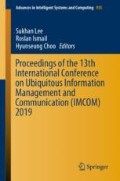Abstract
Crime is one of the most important social problems for administrative region. Ascertaining the detailed characteristics of crime and preparing countermeasures are important to keep community life safe and secure. A lot of studies using crime data and geographical data have been carried out with a view to crime prevention. These studies include analyzing geographical features of crime, mapping crime-related information and crime hotspots on the map, predicting crime rate and so on. In addition, police stations have recently begun emailing notifications regarding crime to citizens to help them avoid crime. The e-mail messages include rich information about regional crime; they are actively used by services providing guidance to people in how to avoid crime. These services map the messages onto regional maps using the location information in the messages and show the relations between the locations and crime on the map. In addition, some services send alarms to their users when the GPS information of the users indicates that they are passing by the places where crime has occurred. However, these services only use the location and crime information extracted from the messages. Thus, we cannot say the messages have been fully used to clarify characteristics of regional crime. Therefore, in this paper, we investigate whether or not the crime messages sent by e-mail can be further exploited as a valid source for analyzing the criminal characteristics of a region, i.e., whether or not they include the characteristics of regional crime. To this end, in this research, we conducted experiments to make clear whether or not the crime messages sent by e-mail can help to distinguish regions. Experimental results illustrate that the contents of e-mail crime messages helped to distinguish regions having greater than or equal to 100 reports, with an average F-measure of about 90.3%, while only using the names of the areas where crime has occurred cannot match that F-measure.
Access this chapter
Tax calculation will be finalised at checkout
Purchases are for personal use only
Notes
- 1.
- 2.
- 3.
- 4.
- 5.
https://ckan.open-governmentdata.org/dataset/fukkeimail (As of Jun 21, 2018).
- 6.
- 7.
References
Amemiya, M., Shimada, T.: The relationship between residents’ fear of crime and spatial compositions in urban areas: a basic study of community-based urban planning for crime prevention. J. City Plan. Inst. Japan 44(3) (2009). (in Japanese)
Belesiotis, A., Papadakis, G., Skoutas, D.: Analyzing and predicting spatial crime distribution using crowdsourced and open data. ACM Trans. Spat. Algorithms Syst. (TSAS) 3(4), 12 (2018)
Buczak, A.L., Gifford, C.M.: Fuzzy association rule mining for community crime pattern discovery. In: ACM SIGKDD Workshop on Intelligence and Security Informatics, p. 2. ACM (2010)
Flanagan, B., Yin, C., Inokuchi, Y., Hirokawa, S.: Supporting interpersonal communication using mind maps. J. Inf. Syst. Educ. 12(1), 13–18 (2013)
Friedman, J.H.: Stochastic gradient boosting. Comput. Stat. Data Anal. 38(4), 367–378 (2002)
Gerber, M.S.: Predicting crime using twitter and kernel density estimation. Decis. Support Syst. 61, 115–125 (2014)
Graif, C., Sampson, R.J.: Spatial heterogeneity in the effects of immigration and diversity on neighborhood homicide rates. Homicide Stud. 13(3), 242–260 (2009)
Harries, K.D., et al.: Mapping crime: principle and practice. Technical report, US Department of Justice, Office of Justice Programs, National Institute of Justice, Crime Mapping Research Center (1999). https://www.ncjrs.gov/pdffiles1/nij/178919.pdf
Hochreiter, S., Schmidhuber, J.: Long short-term memory. Neural Comput. 9(8), 1735–1780 (1997)
Joachims, T.: A support vector method for multivariate performance measures. In: Proceedings of the 22nd International Conference on Machine Learning, pp. 377–384. ACM (2005)
Kaylen, M.T., Pridemore, W.A.: Social disorganization and crime in rural communities: the first direct test of the systemic model. Br. J. Criminol. 53(5), 905–923 (2013). https://academic.oup.com/bjc/article/53/5/905/337849
LeCun, Y., Bengio, Y., Hinton, G.: Deep learning. Nature 521(7553), 436 (2015)
Lin, Y., Yamaguchi, K., Mine, T., Hirokawa, S.: Is SVM+FS better to satisfy decision by majority ? In: The 3rd International Conference on Soft Computing and Data Mining 2018 (SCDM 2018), pp. 261–271 (2018)
Oyama, T.: Development of geographic crime prediction method in Japan (in Japanese). Technical report, The Nikkoso Research Foundation for Safe Society (2017)
Redmond, M.: Communities and crime data set. http://archive.ics.uci.edu/ml/datasets/Communities+and+Crime
Sakai, T., Hirokawa, S.: Feature words that classify problem sentence in scientific article. In: the 14th International Conference on Information Integration and Web-based Applications & Services, pp. 360–367. ACM (2012)
Shihadeh, E.S., Winters, L.: Church, place, and crime: latinos and homicide in new destinations. Sociol. Inq. 80(4), 628–649 (2010). https://onlinelibrary.wiley.com/doi/abs/10.1111/j.1475-682X.2010.00355.x
Takahashi, S., Kikuchi, H., Ochiai, K., Fukazawa, Y.: Exraction of criminal related posts from microblogs based on rarity and influence. J. Inf. Process. 58(8), 1376–1386 (2017). (in Japanese)
Wang, H., Kifer, D., Graif, C., Li, Z.: Crime rate inference with big data. In: Proceedings of the 22nd ACM SIGKDD International Conference on Knowledge Discovery and Data Mining, pp. 635–644. ACM (2016). https://dl.acm.org/citation.cfm?id=2939736
Wang, K., Cai, Z., Zhu, P., Cui, P., Zhu, H., Li, Y.: Adopting data interpretation on mining fine-grained near-repeat patterns in crimes. J. Forensic Legal Med. 55, 76–86 (2018). https://www.sciencedirect.com/science/article/pii/S1752928X18300313
Yamamoto, K.: Current situations of sex-related crime in Fukuoka prefecture and its enlightenment activities (in Japanese). Technical report (2017). http://www.police.pref.fukuoka.jp/data/open/cnt/3/42504/1/04yamamoto.pdf
Zhang, Y., Haghani, A.: A gradient boosting method to improve travel time prediction. Transp. Res. Part C Emerg. Technol. 58, 308–324 (2015)
Acknowledgement
This work was partially supported by JSPS KAKENHI Grant No. JP15H05708, JP16H02926, JP17H01843, and JP18K18656.
Author information
Authors and Affiliations
Corresponding author
Editor information
Editors and Affiliations
Rights and permissions
Copyright information
© 2019 Springer Nature Switzerland AG
About this paper
Cite this paper
Mine, T., Hirokawa, S., Suzuki, T. (2019). Does Crime Activity Report Reveal Regional Characteristics?. In: Lee, S., Ismail, R., Choo, H. (eds) Proceedings of the 13th International Conference on Ubiquitous Information Management and Communication (IMCOM) 2019. IMCOM 2019. Advances in Intelligent Systems and Computing, vol 935. Springer, Cham. https://doi.org/10.1007/978-3-030-19063-7_46
Download citation
DOI: https://doi.org/10.1007/978-3-030-19063-7_46
Published:
Publisher Name: Springer, Cham
Print ISBN: 978-3-030-19062-0
Online ISBN: 978-3-030-19063-7
eBook Packages: Intelligent Technologies and RoboticsIntelligent Technologies and Robotics (R0)

